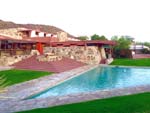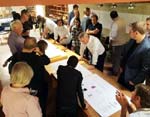
|

|
|
Home Site Search Contact Us Subscribe
|
|
Aaron Betsky: Experiment and Experience at Taliesin - and Beyond Architecture, according to Betsky, is everything that is about building or buildings: how we design, represent, and discuss them, what they mean, and how they act in our society. By Effie Bouras, Ph.D. June 6, 2019 “People often confuse buildings and architecture,” asserts Aaron Betsky, president of The School of Architecture at Taliesin (formerly the Frank Lloyd Wright School of Architecture). It was a response to a question that cursorily touched on the current state of the profession and in some respects, one could argue, the past as well. Following a long pause, he continues his thought when prompted with the assertion that only a miniscule fraction of the built environment could indeed be considered architecture. He agrees, adding that 99% of building is a corollary representation of financial restrictions and code-driven design. Building, according to Betsky, is the “act of building.” Architecture, he argues, is the effect of a good building, which can be defined as a complete representation of architecture. However, he cautions, oftentimes these expressions end up being the “tomb of architecture” – a place where the design is so inextricably embedded within the mundane technicalities of building that it is often very difficult to find, or even see.
Betsky’s dogmatic agreement with the statement that only 1% of all building is architecture may sound like an excerpt from a tome of the Cynic philosophers of ancient Greece, but one can’t help but pay heed. His extensive and prolific career as an architect, curator, critic, and now dean has refined his design acumen to a sharp point. But it all began in his most formative years as a child growing up in the Netherlands. The historic legacy of the Dutch style of architecture holds its own alongside many of the celebrated modernist masters of other genres; to this day, many designers have utilized elements of its controlled elegance in their work. For Betsky, it was the colorful linearity of Gerrit Rietveld’s Schröder House in Utrecht that stood as an icon and helped to solidify his forthcoming interests. Betsky’s early experiences with the Schröder House left him with an indelible impression that good architecture communicates on not only an intellectual level, but on an instinctive one as well. As a child, not having prior knowledge of Rietveld’s work, the building communicated a level of sophistication that brought the whimsy of art into a rigid and practical, yet elegant form. Betsky attributes this to the fact that Rietveld fully realized his intentions within the structure, from conception to construction, while decisively keeping its unique architectural narrative intact.
Industrial Processes
Technology has significantly changed how many now approach the profession, and to Betsky this may be a positive step, allowing for the creation of much more “varied and freer structures than what we could have imagined prior.” But this is not without consequence. During the mid-20th century, Le Corbusier famously touted a new form of architecture that was based upon a defined standardization of housing. This new living unit, he decreed, was as “a machine for living in,” borrowing heavily from the repetitive nature of fast-developing industrialized processes of the new industrial age. However prevalent the technological undertones of Le Corbusier’s narratives and realized buildings were, he never once allowed design to become an afterthought.
There is a danger in letting technology gain too much control over the design process. In a sense, according to Betsky, we have already allowed this. In many instances, design has become so methodically automated that the architect has become essentially redundant. “In many ways,” Betsky says, “they don’t need architects to design buildings any more, the same way that lawyers don’t need a lot of people to create their briefs.”
At the same time, the school at Taliesen does embrace emerging technology, but chooses to focus on how technology can combine with more traditional techniques to create a more perfect union. “We just had a studio with our first-year students, where they looked at the concept of Wright’s textile block, and the unit construction of the Usonian house,” Betsky explains. “They explored whether we could find some way technology could carry [Wright’s building methods] forward.”
How do we, as a collective, initiate a shift to change an absolute reliance on technology? Betsky proposes that we modify our perspectives by shifting the motivation from the obsessive creation of buildings as icons, to looking for the potentials within the spaces between and beyond them. Employing urbanism and networks within the landscape will likely create better, more sustainable urban environments. Parallel to this is focusing our work on reimagining and reusing abandoned/existing structures. This should be in combination with a willingness to learn from the storied traditions of professions such as interior design and set decoration, which have been largely overlooked by architectural pedagogy. These disciplines, according to Betsky, have historically employed modest techniques within minimal means to produce “a great deal of art in existing structures.”
The Functional Experiment
At Taliesin, Betsky is creating an academic base for change by coupling experimental school – and community-based construction projects. Although he must work within the constraints of an established standard of architectural education, he does succeed in “drawing outside the lines,” establishing exploratory projects within the surrounding community, backed by the constructs of rigorous theoretical precepts. Other than the long-standing shelter program, where students build and inhabit a “proof of concept” project that borders on the edge of functional art, he has established a strong affiliation with the Arizona towns of Globe and Miami, where his students are now in the wrap-up phase of an impressive major urban retrofit.
Performing “acupunctural urbanism,” Betsky initiated a series of small interventions ranging from the minute, such as painting city walls, modest revamps, and community gardens, to the more ambitious, including schemes outlining extensive renovations of the historic Sunrise High School and main library in Miami, AZ. Success with local efforts have emboldened Betsky and his students, and they are now in talks to sign a contract with the American Academy in China, where they will study the intersection of agriculture, cuisine, and architecture – specifically, how these disparate themes can unite.
For Taliesin, Betsky sees more organizational changes in the near future. Specifically on his agenda is growth, which he describes as a critically limiting factor in program development. “Gaining this critical mass is key to completing larger scale projects,” he laments, as many potential collaborators have been turned away simply because there are not enough students to meaningfully engage in the projects. He foresees that once he has the numbers needed, his focus will turn toward larger infrastructural works, including confronting traditional notions of sprawl facing the neighboring metropolitan areas surrounding Taliesin. He would also like to explore more recent offshoots of urbanity, including notions of “exurban sprawl,” which, Betsky explains, are areas that encompass a character that is simultaneously suburban and rural – a condition that is currently facing Spring Green, Wisconsin, where Taliesin East is sited.
Pragmatism in the Desert
Betsky’s penchant for experimentation is rooted within a profound philosophical pedigree. Deeply influenced by radical practitioners such as the Italian architectural group Superstudio and their progeny, the once paper-based studio of Rem Koolhaas’s Office for Metropolitan Architecture (OMA), whose once seemingly fantastical structures have now become reality, Betsky has taken the lessons of his predecessors seriously. When asked to define the word “experiment,” however, he does so in the sense of the American pragmatists, a philosophical movement that emerged from the United States in the late 19th century and was fronted by Charles Peirce, a scientist by trade. Pragmatists concretized thought through practical application, oftentimes utilizing existing technologies, which were mostly crude in nature, in combination with tests involving “human experiences,” in order to test the limits of what might be possible.
Analogous to the Pragmatists, Betsky references the desert shelter program, concentrating on a Taliesin tradition known as “desert concrete,” or “masonry getting.” This involves, ironically, utilizing as little concrete as possible in the construction of the students’ shelters. In recent years, Betsky has asked the students to push their concepts and techniques further. Noticing that locals are actively using the desert surrounds of Taliesin as a dumping ground for various accoutrements, including bed frames, tools, and beer cans, he has asked students to incorporate these “found objects” in their shelters or use within their construction method(s).
Frank Lloyd Wright is safe with Betsky. The school remains a work in progress, as Wright intended. Betsky, building upon Wright’s legacy as a pioneer of contemporary, exploratory, architectural education and practice, adds: “[We] are trying to build upon what FLW brought to the desert – that you don’t build boxes, you don’t build off the land, but you build with the land...that you see your work as an unfolding of the interior towards the exterior, those are all focal points that we are trying to continue in our teaching.” Because of this, the school does not only embody its place in history as one of the few living, successful time capsules of “apprentice-based” architectural pedagogy – a much needed counterpoint to an over-reliance on a seemingly runaway technological spectacle – but as a place that continuously reinvents what it means to create.
Effie Bouras, Ph.D., has designed objects + buildings – everything from exhibit design and environmental art, to full-scale building projects. Her work has been featured in international and national publications, and she has been a featured guest on shows broadcast by TVOntario, Discovery Asia, and PBS. As a postdoctoral fellow at McGill University Department of Civil Engineering, her work gauged the seismic vulnerability/risk mitigation of non-structural components in post-critical buildings, specifically Montreal area hospitals. This led to her designing the exhibition “Considering the Quake: Seismic Design on the Edge,” which scrutinized the intersection of architectural storytelling and the technicalities of building through the lens of earthquake engineering. The exhibit debuted at the Design Exchange in Toronto, then traveled to other venues, including the Center for Architecture in New York City. Academically, Bouras has served as an adjunct professor and guest lecturer and critic at several schools, including The School of Architecture at Taliesin.
|
(click on pictures to enlarge)  Andrew Pielage Taliesen West  Andrew Pielage Aaron Betsky  Andrew Pielage Aaron Betsky with students and faculty at The School of Architecture at Taliesin (formerly the Frank Lloyd Wright School of Architecture). |
© 2019 ArchNewsNow.com